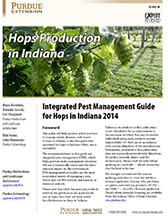Purdue Extension guide helps farmers control pests, diseases in hops fields
August 26, 2014
 |
|
Cover of the Purdue Extension publication Integrated Pest Management Guide for Hops in Indiana 2014. (Purdue Agricultural Communication image) |
WEST LAFAYETTE, Ind. - Farmers interested in learning in-depth information on how to protect their hops from weeds, diseases and insects can find information on integrated pest management in a new Purdue Extension guide.
The Integrated Pest Management Guide for Hops in Indiana 2014 lists pesticides registered for hops in Indiana as well as seven tables of information detailing herbicide, disease and insect information essential for growers to choose which practice is right for their hops operations.
The guide was compiled by members of the Purdue horticulture and landscape architecture and entomology departments as part of their research and extension project on hops production in Indiana. Extension specialist Bruce Bordelon is the lead author.
"We wanted to get basic integrated pest management information to growers because we were getting lots of questions and growers did not have any resources available," Bordelon said.
The other authors are Natasha Cerruti, a research assistant; Lori Hoagland, assistant professor of horticulture; Rick Foster, Extension entomology specialist and coordinator of Extension; and John Obermeyer, Extension entomology specialist. The publication highlights specific threats and treatments in each of three areas:
* Weed management: Contains information on mechanical and chemical methods of weed protection and a table of information on various herbicides.
* Disease management: Points out the most threatening diseases to hops production such as powdery and downy mildew. This section explains chemical, cultural and mechanical ways to control diseases and contains three tables expanding on various fungicides.
* Insect management: Consists of guidelines for choosing the correct insecticide and notes products in two tables, showing which insecticides work best for particular insects.
Bordelon and his colleagues intend to expand the guide in the future.
"We anticipate making annual revisions and updates based on results of our research and experience of growers in the state," Bordelon said. "Additionally, pesticide registrations can and do change each year, and we want to be sure to provide the most accurate information possible to the growers. I think the future version of the guide will be much more comprehensive and will include cultivar selection, nutrition, cover crops, irrigation management, post-harvest handling and marketing."
The publication is available free for download in Purdue Extension's The Education Store. Search for publication ID-462-W.
Writer: Emma Hopkins, 765-494-8402, hopkine@purdue.edu
Source: Bruce Bordelon, 765-494-8212, bordelon@purdue.edu
Ag Communications: (765) 494-2722;
Keith Robinson, robins89@purdue.edu
Agriculture News Page

